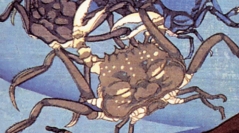In the Dorippidae H. Milne Edwards, 1837, as revised by Holthuis & Manning (1990), ambulatory leg length, which is often utilised as a criterion for specific morphological differentiation, has proved to be a reliable character, even for the few cases where sexual dimorphism is observed in relative lengths. However, the discrepancies in the use of ambulatory leg length by these authors in the case of the iconic East Asian crab Heikeopsis japonica (von Siebold, 1824) is an issue that requires detailed study. The use of ambulatory leg length in dorippids has since been followed up by other researchers, but it is clear that there is a problem with this species. The taxonomy of the Heike-gani crab is therefore examined here in depth. In their revision, Holthuis & Manning (1990) did not discuss or resolve the problem that in H. japonica the first and second ambulatory legs are constantly and consistently long and narrow in adults of both sexes for most specimens in Japan, Taiwan and southern China, whereas the populations from the North China Sea have legs that are usually distinctly shorter and wider. Holthuis & Manning (1990) synonymised the long-legged Neodorippe (Neodorippe) japonica var. taiwanensis Serène & Romimohtarto, 1969 with Heikea japonica (von Siebold, 1824) but, in addition, recognised a new very long-legged species from the Inland Sea in Japan, H. arachnoides (Manning & Holthuis, 1986). While the first and second ambulatory legs of H. arachnoides are relatively longer than in the typical H. japonica from the other parts of Japan, the difference is slight, and the holotype is not a fully adult specimen. Much of the literature on H. japonica from Japan, China, Hong Kong, Taiwan, and Korea does not discriminate between the leg lengths, and most authors follow the prognosis of Holthuis & Manning (1990) for the taxonomy. To better understand the problem with leg lengths in H. japonica, we examined a large series of specimens of these different leg-morphs from across its distribution, including the types of the various taxa. We confirm here that Neodorippe (Neodorippe) japonica var. taiwanensis is a junior synonym of H. japonica s. str. We also show that Heikea arachnoides Manning & Holthuis, 1986, based on not fully-grown individuals, is clearly a junior synonym of H. japonica s. str. as we demonstrate here that subadults and juveniles usually have proportionately longer and more slender first and second ambulatory legs. Notably, while all adult specimens from northern Chinese waters have shorter legs in contrast to those from other areas, this character is not unique to them: there were some specimens from Japan, Taiwan and southern China that possess relatively shorter legs as well, and others that belonged to the typical long-legged morph. Detailed morphological examination (including gonopods) of hundreds of specimens and analysis of sequence data for the mitochondrial 16S rRNA gene did not reveal any significant characters that could be used to separate the two morphs. This may be one of the very first cases of incipient speciation or cladogenesis taking place in a widely distributed species, with the northern Chinese population beginning to be isolated, but not long enough for other morphological and/or genetic characters to manifest themselves.


 Zoosystema
46 (31) - Pages 775-811
Zoosystema
46 (31) - Pages 775-811